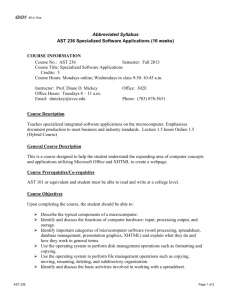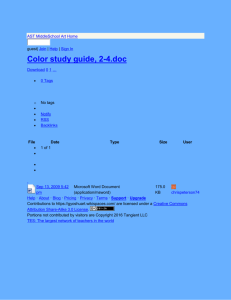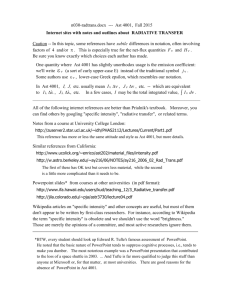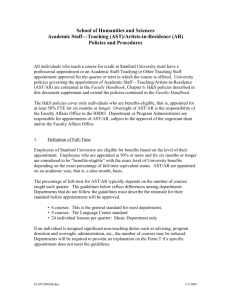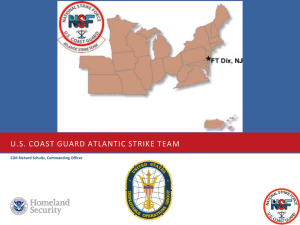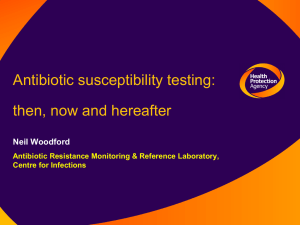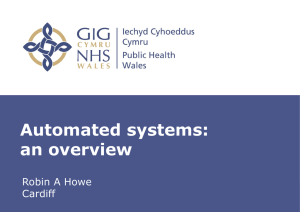Contemporary Issues in Antimicrobial Susceptibility Testing for
advertisement
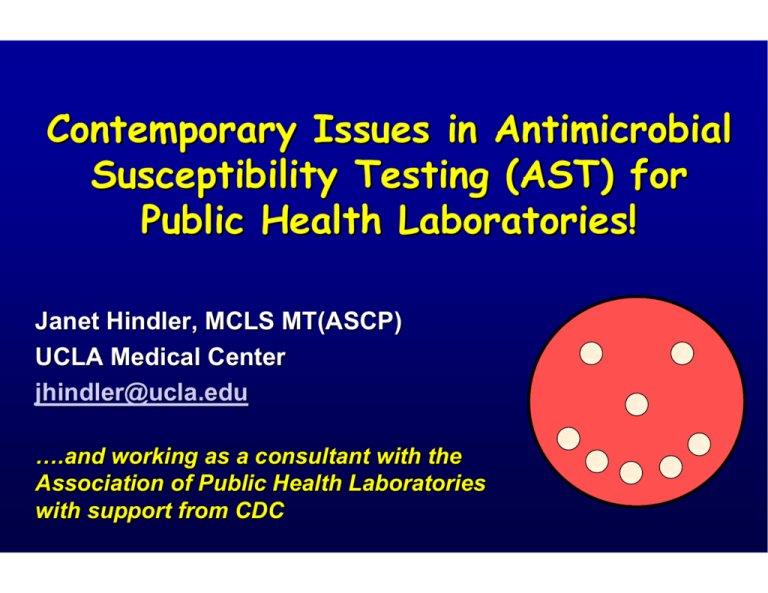
Contemporary Issues in Antimicrobial Susceptibility Testing (AST) for Public Health Laboratories! Janet Hindler, MCLS MT(ASCP) UCLA Medical Center jhindler@ucla.edu ….and working as a consultant with the Association of Public Health Laboratories with support from CDC At the conclusion of this talk, you will be able to…… ♦ Describe what is currently being done in PHLs re: antimicrobial susceptibility testing (AST). ♦ List features, benefits, and costs of commonly used automated and non-automated AST systems. ♦ Discuss the role of the PHL in assisting clinical laboratories with AST problems including emerging resistance (e.g., CA-MRSA, VISA, VRSA). ♦ List resources available for performance of AST and ways in which PHLs may help to provide access to these resources. What are PHLs doing now re: AST? AST State PHL Training Needs Survey 2005 ♦ 36/52 responses (69%) – 2 states >1 lab responded ♦ 29/36 labs do some type of AST – 16 referral testing – 10 diagnostic testing – 25 surveillance ♦ Desire more training in AST – 29/36 for surveillance – 13/36 for diagnostic testing Number of State PHLs Performing AST on Respective Organisms* For Surveillance For Diagnostics Campylobacter 4 2 Salmonella spp. 19 6 N. gonorrhoeae 14 7 N. meningitidis 4 1 S. aureus 21 11 S. pneumoniae 12 5 Group B streptococci 2 6 Organism * of 36 labs that responded Number of State PHLs Using Test Methods* Disk Diff Etest Broth Dilution Campylobacter 3 3 - Salmonella spp. 1 12 2 3 N. gonorrhoeae 10 7 1 N. meningitidis 1 3 1 S. aureus 6 15 8 S. pneumoniae 7 10 2 Group B streptococci 2 1 2 Organism * of 36 labs that responded; 1 Vitek (2) Additional Data from AST State PHL Survey ♦ 9/36 said that their epidemiology section collects cumulative antibiogram data from clinical laboratories ♦ Additional AST Methods Utilization – Vitek – 3 – MicroScan – 2 – Sensititre – 1 ♦ 23/36 labs use Etest for one or more organisms AST State PHL Survey Spring 2005 AK VT NH WA MT OR MN CA No Response AZ CO IA IL KS OK NM TX HA RI MI NE UT MA NY WY NV Do No AST WI SD ID Do Some AST ME ND OH IN KY MO WV VA AR SC AL NJ DE NC TN MS CT PA MD GA LA FL PR What methods/systems are available for AST? Who makes the rules for AST and reporting of clinical isolates? ♦ The Clinical and Laboratory Standards Institute (CLSI, formerly NCCLS) subcommittee on AST – Virtually all labs in USA follow CLSI standards – Each lab must customize testing and reporting to meet the needs of the facilities they serve – Accrediting agency requirements primarily based on CLSI recommendations ♦ FDA has rules for manufacturers of AST systems Current CLSI AST Standards ♦ M100-S16 Tables (2006)* …..to be used with text documents explaining how to perform the tests…. M2-A9 Disk Diffusion (2006)** M7-A7 MIC (2006)** ♦ M45-P Infrequently Isolated/Fastidious Bacteria (NEW, 2005) * M100 updated yearly **M2, M7 updated every 3 years What drugs should we test / report? CLSI M100-S16 Table 1 Drugs to Test/Report How should we interpret results? CLSI M100-S16 Table 2C Interpretive Criteria (Breakpoints) How can we ensure accurate results? CLSI M100-S16 Table 3 QC Strain Ranges Clinical lab can use a CLSI reference method….. Broth microdilution MIC - + 0.5 1 2 4 8 16 32 64 Disk diffusion (Kirby Bauer) Drug >64 >64 A B C D …or an FDA-cleared commercial system Etest Vitek 2 MicroScan Sensititre BIOMIC Phoenix Comparison of AST Systems CLSI Disk Diff BIO MIC Etest Micro Phoenix Sensititre Scan Identification of bacteria - X - X X X X AST fastidious bacteria X X X X X X X Automated read - X - X X X X Rapid result option - - - X X X X Manual read option X -* X X -* X -* Cost/panel of 10 drugs (approx) $2 $2 $22 $7 - 10 $7 - 10 $7 - 10 $7 - 10 -*, significant capital equipment cost Vitek Why would a PHL do AST? – Emerging antimicrobial resistance (AR) is a PH concern – Clinical labs sometimes need help with detection of emerging resistance Why would a PHL NOT do AST? – Limited resources – Clinical labs have expertise in AST “PHLs: Potential Leaders in the Fight Against Antimicrobial Resistance” (APHL Minute, May-June, 2006) Approaches to AR & AST in a PHL… ♦ Test isolates “referred” from clinical labs (“referral” isolates) – To verify noteworthy results from clinical lab – To test supplemental drugs on highly resistant bacteria – To do tests not done in smaller clinical lab [e.g., extendedspectrum β-lactamase (ESBL) confirmatory test; mecA, etc.] – Clinical labs on “front line” ♦ Surveillance for AR ♦ Test isolates from diagnostic specimens ♦ QA of AR detection / reporting CLSI M100-S16 (2006) Table 8 (M7) What isolates should be “verified” and possibly referred? Excerpt from: “Suggestions for Verification of AST Results and Confirmation of Organism Identification” Organism or Group Staphylococcus aureus Streptococcus pneumoniae NS, not susceptible Category I Verify at all labs linezolid – NS vancomycin – I or R vancomycin – NS Category II Verify – institution specific oxacillin – R penicillin – R CLSI M100-S16 Tables 4 (M2) and 8 (M7) What is the basis of the “suggestions for verification” list? ♦List includes results that.. – have never been documented* – have rarely been documented – can easily result from technical errors *critical PH importance! Algorithm for Testing S. aureus with Vancomycin (VA) Acceptable Primary Test Methods Include: MIC method plus VA screen plate1 (BHIA with 6 µg/ml of VA) VA MIC <2 µg/ml AND NO growth on VA screen plate VA MIC = 4 µg/ml AND/OR GROWTH on VA screen plate Report VSSA3 Possible VISA/VRSA Disk diffusion plus VA screen plate2 (BHIA with 6 µg/ml of VA) VA zone <15 mm AND/OR GROWTH on VA screen plate VA zone >15 mm AND GROWTH on VA screen plate Possible VISA/VRSA VA zone >15 mm AND NO growth on VA screen plate Report Probable VSSA3 CHECK for purity Clinical and Laboratory Standards Institute S. aureus/Vancomycin Breakpoints (M100-S16; Jan. 2006) Susceptible: ¡Â2 µg/ml (VSSA) Intermediate: 4-8 µg/ml (VISA) Resistant: ¡Ã16 µg/ml (VRSA) CONFIRM isolate ID Algorithm Revised: March 31, 2006 RETEST using a validated MIC method4 SAVE ISOLATE NOTIFY infection control, physician, local health department and CDC5 of “possible VISA/VRSA” SEND to reference laboratory for confirmation Important Footnotes 1 Laboratories using automated MIC methods that have not been validated for VRSA detection should add a commercial VA agar screen plate (6 µg/ml). 2 Disk diffusion will not differentiate VISA (MICs 4-8) from susceptible strains (MICs 0.5-2). VA screen plate will not reliably detect strains for which MIC=4. 3 If concerned about a result based on a patient’s history, send to a reference lab for MIC testing. 4 Validated methods: reference broth microdilution, agar dilution, Etest® (0.5 McFarland inoculum, Mueller-Hinton agar), MicroScan® overnight and Synergies plus™; BD Phoenix™ system. For other automated methods, check with the manufacturer about FDA-clearance to detect MICs =4 (i.e., VISA/VRSA). 5 Report to CDC by email: SEARCH@cdc.gov More VISA/VRSA info: http://www.cdc.gov/ncidod/dhqp/ar_visavrsa.html Streptococcus pneumoniae Vancomycin Susc Int Res DD (mm) ≥17 - - MIC (µg/ml) ≤1 - - *CLSI states: investigate non- susceptible (NS) result ..Repeat identification and AST ..Save isolate ..Send to reference lab Where do Clinical Labs need help with “referral” isolates? Resistance VISA, VRSA Clinical Labs need help to rapidly and accurately…. Characterize CA-MRSA vs. HA-MRSA (?outbreaks) – rapid result not always essential Verify VRE Test broad spectrum drugs DRSP Test certain drugs by MIC (systemic isolates) MRSA Where do Clinical Labs need help with “referral” isolates? (con’t)? Resistance ESBL Multidrug-R GNR Other Clinical Labs need help to rapidly and accurately…. Perform confirmatory test (smaller labs often don’t do confirmatory test) Test broad spectrum drugs Verify unusual results (e.g., vancomycin-NS S. pneumoniae; imipenem-R Klebsiella spp.) AST of Referral Isolates ♦ Preferred AST method = CLSI broth microdilution MIC reference method …or ♦ Method proven reliable by CDC ♦ Etest sometimes an option ♦ Must be aware of pitfalls of certain AST methods to reliably resolve equivocal results or identify emerging resistance ♦ Often requires expertise PHL Surveillance for AR ♦ Compile AST data to answer specific question, e.g., – How many MRSA from EMC patients are susceptible to trimethoprim-sulfamethoxazole? clindamycin? ♦ Collect isolates from the community and test ♦ Alternative, collect data from hospital laboratories ♦ Must consider all factors that might impact data, e.g., – – – – Isolates or drugs selectively tested? Inclusion / exclusion of duplicate isolates on a patient? Hospitalization history? Clonal isolates from a given facility? CLSI M39-A2 Guideline “Analysis and Presentation of Cumulative Antimicrobial Susceptibility Test Data” Purpose: aid in preparation of cumulative antibiogram reports to guide empiric therapy of initial infections. Relative importance of requirements of AST system depending on purpose of testing (Hindler opinion!)….. Requirement Referral Surveillance Accuracy 5 4 Turn around time 5 1 MIC result (vs. S I R only) 5 3 (depends on question posed) Cost 3 5 AST expertise 5 4 Scale = 1 (least important) to 5 (extremely important) What resources (in addition to CLSI standards) are available for keeping appraised of new developments in AST? http://www.phppo.cdc.gov/nltn/default.aspx NLTN To view Jan 2006 teleconference details of M100-S16 CDC AST CD-ROM ♦ Modes of action / mechanisms of resistance ♦ Methods ♦ Gram-positive bacteria ♦ Gram-negative bacteria If your lab does NOT have a copy of this, please email jhindler@ucla.edu. www.phppo.cdc.gov/dls/master/default.asp American Society for Microbiology Online Features! http://www.asm.org/division/c/greatfeatures.htm http://www.cdc.gov/ncidod/dhqp/pdf/ar/CAMRSA_ExpMtgStrategies.pdf Summary of Expectations….. PHL expects Clin Lab to provide: Clin Lab expects PHL to provide: • Isolates w/ unusual “R” (e.g., VRSA) • Strategy for verification of unusual isolates • “New” Technical information from CDC / APHL / Others • Notice of training events ….maybe • Cumulative antibiogram data …maybe • Regional antibiogram data • CLSI AST standards How can PHLs help Clinical Labs now…for minimal $$$$? ♦ Inform them of resources for verification of “referral” isolates – PHL? (test in house or send to CDC) – Local university lab or reference lab – partner??? ♦ Inform them which isolates with specific R should be reported to PH department ♦ Inform them of any emerging R bug problem in their state rapidly! – e.g., ceftriaxone-R Salmonella spp. How can PHLs help Clinical Labs now…for minimal $$$$ (con’t)? ♦Inform them of what the state PHL (or Epi) is doing re: AR ♦Provide education on new AR and AST issues – Many materials provided by National Laboratory Training Network (NLTN) – CLSI standards for AST Meeting Antimicrobial Resistance Challenges PHLs (& Epi) State Training Coordinators NLTN APHL Clin Labs NLTN Ongoing Efforts re: AST ♦PHL-directed webcasts on AST – March 2006 (AST systems) – May 2006 (VISA, VRSA, MRSA) – More planned! ♦Programs for clinical labs ♦Assist individual PHLs with specific needs “I would ask PHLs to look for ways that they can become more integrated with clinical labs and develop strategies for ensuring accurate AST. Good surveillance data is the lynchpin for all our work.” Todd Weber, MD; Director of CDCs Office or AR (APHL Minute, May-June, 2006)
